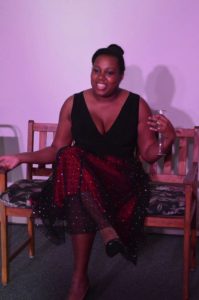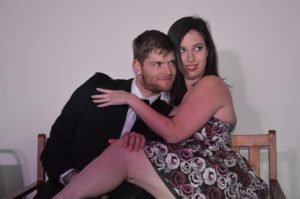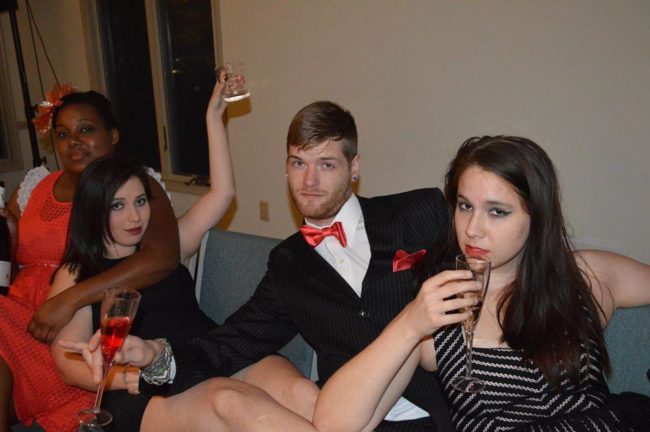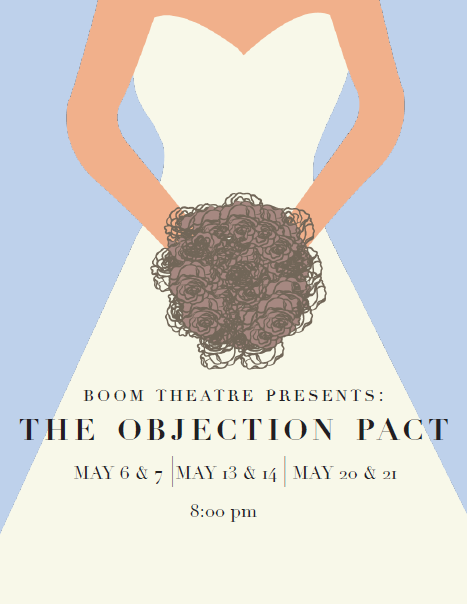Do you really have to lose yourself to love somebody else? Sure, give them a piece of your soul, a piece of your heart, but is a total merger of two people into one person really a necessity when it comes to love and marriage, particularly the latter part? If so, at least when it comes to marriage? You’re doing it wrong. BOOM Theatre Company presents the world premiere of Samantha Allen’s first script, The Objection Pact. A short play revolving around the struggles of marriage in the modern age, the show falls in step with the company’s mission of developing and workshopping new pieces of theatre, giving new work a chance to see the lights of the stage. Directed by Allen with a minimalist production team, as is another tried and true tenant of the company’s theatrical practices, the show is off to a sturdy start for its first go up on its feet.
Chris Allen deserves a note of praise for his dedicated design work as the show’s Lighting Designer, although there is precious little of it on display until the show’s penultimate scene, which is a bizarrely absurdist concept that outsteps the rest of the show’s continuity. Early on Allen uses a blue dimmer light to focus on a character who pauses his interactive scene dialogue with the other performers to address the audience, but as this vice is later shared with great inconsistency among the other actors, the lighting gimmick fades out of us. Allen’s strobe effects are wildly colorful and do create the right atmospheric fusion of disorienting party when they are brought into the show near its conclusion.

Performances across the span of the show waver somewhat unevenly but as BOOM Theatre Company is a space of cultivation and designed to encourage those with lesser experience so that they can get shows under their belt, this is not a major point of concern for the show as a whole. Playwright Samantha Allen’s characters, which appear to be constructed wholly on stereotype, make it difficult for the actors to connect on a deep or meaningful level, which may account for some of the more stagnant performances. Brandon Beatty is a scene-stealer in the character track, taking on three separate roles as the bride’s father, the waiter, and a wedding date toward the show’s end, all three of which are delivered with distinctive voices, mannerisms, and other affectations to separate one from the other.
It is somewhat of a rarity to see a playwright of a brand new work also serving as the show’s Director and in this case for Allen, it appears to be a misstep. Not giving the plot and characters a chance to be exposed to outside eyes limits the growth potential for the story as a whole. Allen’s work possesses a great deal of potential as she addresses nearly a dozen exceptional points about marriage in the modern world, defining relationships, the struggles of dating in today’s society, and several other notions that all fit loosely under the banner of wedlock. Allen’s main issue in her script’s construction is that she’s trying to fit too many important topics into one show and her attempt to do so pulls the focus of the audience in one too many directions without consistency or clarity.
Allen approaches great topics— like how marriage is seen as more of an accomplishment than graduating from a prestigious university with her momentary social media comparison of an engagement photo versus a graduation picture on Facebook— and how the concept of a wedding has deviated away from two people coming together to share their life and turned into a spectacle all about gowns, cakes, and how many bride’s maids you can stuff into fluffy balls of taffeta. Unfortunately a great many of these relevant conversation-sparking topics are lost in the disjointed framework that Allen has settled over the play.

Initially the audience is introduced to Aidan (Bryan McGee, who performs the role with a snappy and sassy attitude, playing wholly to the stereotype of “the gay best friend” from a millennial version of Sex in the City.) Right from the get-go, Allen brings Aidan forth with monologues that directly address the audience but still within a contained context. We’re aware he is speaking aloud to us but not directly at us. But this tool isn’t used with great success or consistency as the play goes along. Other characters are given these confession-style monologues that address the audience in as similar fashion, again with great contemplative facts and opinions about marriage, relationships, and the construct of dating in the modern world, but feel unnatural in the way the characters are setup to deliver them. Allen has tremendous insight on just why millennials won’t settle down and all of the social and familial pressures that go along with doing so at weddings, and has so many opinions regarding these topics, but fails to include them in a fluid and cohesive fashion. The result is four characters preaching at the audience as a separate entity that feel as if it’s occurring outside of the play itself.
Allen attempts something unique with the script— giving the audience the chance to “choose the ending”, which is a bold and daring move, that unfortunately does not pay off. Circling the premise that four friends make a pact to object at their other friend’s wedding because they don’t believe that the couple is suited for one another, the optional endings include various friends getting their chance to object, along with an extra option of “no objection.” Votes are tallied during the intermission and the show’s conclusion is reached by majority rules. The problem herein lies that the character’s motivations for objecting are never made clear. At the opening night performance, the audience chose Aidan’s objection, but what comes out of his mouth to stop the wedding arrives from so far out in left field that it’s an abrasive shock to the audience that doesn’t make sense with the rest of what has been established up to that point. Having only seen the one conclusion, I cannot speak for whether or not the other characters’ objections make sense or follow with what they’ve established in the story, but on the whole as the play progresses, these reasons are not made clear.
A great deal of the dialogue that is exchanged throughout the performance feels trite, but this is difficult to say if it’s the lack of character development or the show’s unforgivably slow pacing. The characters seem to mirror television archetypes from the late 90’s and early 00’s and their dialogue reflects that. Unfortunately, many of these lines lack the pop and sparkle and drive that Allen intends because each line— particularly during the scenes where the characters interact with each other— are treated as a separate beat. There is no conversational flow and this stifles the action as a whole in addition to the audience’s ability to be able to grasp a sense of who these characters are.

Allen’s strongest characterization comes through in Aidan. The other three girls, Jo (Victoria Scott), Olivia (Zoë DiGiorgio) and Gwen (Ashley Harris) run together in their overall character tone— each having somewhat of a frigid chip on their shoulder with a Sex and the City sensibility about what comes out of their mouths. While Scott, DiGiorgio, and Harris do a fine job of being catty and delivering their direct addresses to the audience, their performances float blissfully on the surface of these constructs. Brandon Beatty, as the waiter, delivers one of the most potent lines of the script, addressing the notion that a marriage is two people coming together to share their lives and if they can’t plan a wedding together how are they going to face bigger challenges together down the line?
There are a few questionable moments penned into the script as well that raise the questions of acceptance across the lines of race, gender and sexual preference and because of the way the stereotypes are so heavily ingrained in the character creation, these moments might be misconstrued or interpreted as unfavorable. In addition to these lines that have the potential to be viewed as insensitive, there is a great deal of focus spent on characters that never appear. While it is important to establish who the play is about, the opening scene is a superfluous and confusing account of who’s who at the upcoming wedding, many of whom never get mentioned again. Despite the show’s many working issues, the play has a great deal of promise and potential for growth, once workshopped and the focus realigned. There are strong concepts that need fleshing out contained within the new script, and further character development to really articulate these characters and ideas in a fashion that would better reach Allen’s target audience.
Running Time: Approximately 75 minutes with one intermission
The Objection Pact plays through May 21, 2016 at BOOM Theatre Company at the Unitarian Universalists of Fallston— 1127 Old Fallston Road in Fallston, MD. Tickets can be purchased at the door or in advance online.

